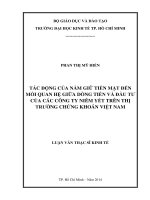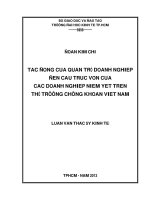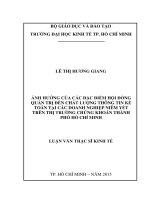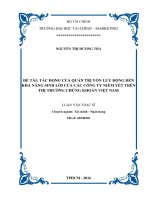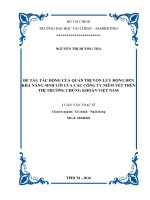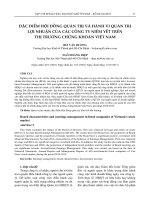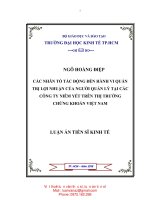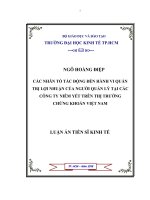Tác động của đặc điểm quản trị công ty đến việc thực hiện nguyên tắc thận trọng trong kế toán tại các công ty niêm yết trên thị trường chứng khoán việt nam tt tiếng anh
Bạn đang xem bản rút gọn của tài liệu. Xem và tải ngay bản đầy đủ của tài liệu tại đây (170.58 KB, 7 trang )
1
2
CHAPTER 1
Thirdly, to evaluate the impacts of characteristics of corporate governance on the implementation of conservatism in
accounting of non-financial enterprises listed on Vietnam stock market.
INTRODUCTION
1.1. Rationales
Conservatism is one of fundamental accounting principles. Also, it is a commonly required criteria during the
accounting process. The performance of this principle puts an impact on the determination of value of items shown in the
balance sheet, which, consequently affects honesty, reliability and usefulness of accounting information. The importance of
this principle was recognized by International Accounting Standards Board (IASB) through its inclusion of conservation in
the conceptual framework as well as its requirement of huge conservation reflection in specific items of International
Financial Reporting Standards (IFRS).
A certain number of previous studies revealed the avantages of implementing conservatism in accounting such as
allowing management board to early identify projects with negative present value (Ball, 2001), increasing future investment
opportunities (Garcia Lara et. al, 2009), mitigating managerial opportusim (Watts, 2003; Chen et. al, 2007), decreasing
earnings management (Watts, 2003), and improving enterprises’ value (Watts and Zuo, 2012), etc. However, in reality,
enterprises might take advantage of conservatism principle in accounting as an approach to make up subjective information
in the balance sheet serving different aims like establishing sinking fund “on purpose”, exceeding reserves, and consciously
delaying interest recognition, etc. In addition, the imbalance in recording would influence the focus of accounting
information, resulting in conflicts about the impact of implementing conservatism . Therefore, IASB excluded conservatism
from the conceptual framework in the edited version in 2010. However, this change caused controversies due to careless
assessment of transactions and uncertain events of enterprises. Noticeably, despite the non-existence of conservatism in the
conceptual framework, the requirement for this criteria is still compulsory in recording, determining the value and
announcing information (IAS 2, IAS16, IAS 19, IAS 36, IAS 37, IAS 39, IAS 40, IFRS 2, IFRS 4, IFRS 5, IFRS 7, IFRS
9). Thus, in the draft of IASB’s conceptual framework amendment in 2015, the principle of conservatism was reincluded.
Forthly, to propose recommendations for the implementation of conservatism in accounting non-financial enterprises
listed on Vietnam stock market.
1.3. Research questions
Question 1: Which charactersitics of corporate governance have impacts on the implementation of conservatism in
accounting of listed enterprises on Vietnam stock market? How to measure these characteristics?
Question 2: What are models used to measure the implementation of conservatism in accounting?
Question 3: How are results of measuring the implementation of conservatism in accounting of listed enterprises on
Vietnam stock market under the model by Ahmed & Duellman (2007)?
Question 4: How do characteristics of corporate governance influence the implementation of conservatism in
accounting of non-financial enterprises listed on Vietnam stock market?
Question 5: What are recommendations for enteprises, investors, state authorities and institutions to implement
conservatism in accounting?
1.4. Research subject and scope
1.4.1.
1.4.2.
Based on the importance of performing conservatism in accounting as well as its negative and positive impacts, it is
essential to apply an observatory mechanism for enterprises’ internal and external implementation of this principle. From
the perspective of internal performance, corporate governance’s features are regarded as one of influencing factors on the
implementation of conservatism in accounting. Corporate governance is derived from the separation between corporate
control and ownership as well as concentration on solutions to arising problems related to principle-agent, prevention and
mitigation of owners’ abuse of position and power to use corporate assets and take business opportunities for personal/
others’ purposes or lose resources under the control of corporate. Good corporate governance would help management
board to make decisions and take actions compatible with mutual spirit and benefits of investors, shareholders and relevant
stakeholders. There have been numerous studies demonstrating that establishment of good corporate governance
mechanism would have positive impact on the implementation of conservatism in accounting (Beekes et. al (2004), Lim
(2011), Lara et. al, (2009), Ahmed and Duellman (2007)….)
In Vietnam, characteristics of corporate governance are related to those of Board of Directors, Board of Supervisory,
Board of Management and capital owning structure of relevant organizations and individuals, etc. Each characteristic has its
own influence on the observation of business activities, then, it would have an impact on the effectiveness of observing the
implementation of conservatism in accounting. Therefore, the impact of corporate governance characteristics on the
implementation of conservatism in accounting is one of the huge concerns in this thesis, which is expected to be clearly
explored.
Based on the above mentioned theories and practice, the thesis on “The impacts of characteristics of corporate
governance on the implementation of conservatism in accounting of listed enterprises on Vietnam stock market” was
carried out.
1.2. Research objectives
Firstly, to identify, determine and measure characteristics of corporate governance, which have impacts on the
implementation of conservatism in accounting of listed enterprises on Vietnam stock market.
Secondly, to measure the implementation of conservatism in accounting of listed enterprises on Vietnam stock
market, which is based on the model by Ahmed & Duellman (2007).
Research subject
The subject of this thesis is the impacts of characteristics of corporate governance on the implementation of
accounting conservatism (ACC) in listed enterprises on Vientam stock market.
Research scope
The thesis conducted an emperical study on database of listed enterprises on Vietnam stock market during the period
of 2012 – 2016 (5 years).
1.5. Resesarch structure
Chapter 1: Introduction
Chapter 2: Literature review on the impacts of characteristics of corporate governance on accounting conservatism
Chapter 3: Theoretical frame, hypothesis and research methods
Chapter 4: Findings and reality of impacts of corporate governance characteristics on the implementation of
accounting conservatism in listed enterprises on Vietnam stock market
Chapter 5: Discussion, conclusions and recommendations
3
CHAPTER 2
THEORETICAL FRAME AND LITERATURE REVIEW ON IMPACTS OF CORPORATE
GOVERNANCE CHARACTERISTICS ON THE IMPLEMENTATION OF ACCOUNTING
CONSERVATISM
4
2.2.
Overview on theories about corporate governance
2.2.1. The root and definition of corporate governance
2.1. General theories on accounting conservatism
Corporate governance (CG) derived from the separation of ownership from control in public companies (joint stock
companies). Currently, there is a quite large number of studies on CG and different concepts related to this issue.
Followings are some widely accepted concepts.
Prudence/conservatism is a common principle (convention), which appeared in accounting long time ago and has
impacts on both theory and practice of accounting. Sterling (1967) described accounting conservatism (ACC) as ‘the oldest
and might be the most common principle in accounting pricing’. May (1943a) defined ACC as one of the oldest accounting
practices. ACC is has been a section and a part of accounting development for centuries.
In this thesis, CG is defined based on the concept given by Organization for Economic Co-operation and
Development (OECD, 2004). In particular, CG covers a consistent establishment of internal measures to control and orient
enterprise activities. So, characteristics of CG are comprised of structures of Board of Directors, Board of Management,
Board of Supervisory, that of ownership, etc in the enterprises.
2.1.1.
2.2.2.
History of accounting conservatism
ACC is an instruction for accountants and managers to estimate and record information in uncertain situations. Level
of ACC implementation depends on subjective purposes of managers and accountants. As a consequence, there would be
both negative and positive impacts of ACC implementation.
2.1.2. Models for accounting conservatism measurement in enterprises
2.1.2.1. Model by Basu (1997)
2.1.2.2. Model by Khan & Watts (2009)
2.1.2.3. Model by Ball and Shivakumar (2005)
2.1.2.4. Model by Feltham & Ohlson (1995), Beaver and Ryan (2000)
2.1.2.5. Model by Givoly and Hayn (2000)
2.1.2.6.
Model by Ahmed & Duellman (2007)
Content and characteristics of corporate governance
Currently, there are more than 200 sets of regulations for CG for more than 72 countries and territories (IFC, 2010),
most of which focus on the role of Board of Supervisory or Board of Directors, some of which are internationally used.
In Vietnam, current valid law in CG in listed enterprises is the Decree 71/2017/NĐ-CP ‘Corporate governance
instructions applied to public companies’, which is in place of the Circular 121/2012/TT-BTC ‘Corporate governance
regulations applied to public companies’.
2.3. Literature review on impacts of gorporate governance characteristics on the implementation of accounting
conservatism
Worldwide studies on the impacts of CG characteristics on the implementation of ACC concentrated on
chacracteristics of Board of Directors, Board of Supervisory and ownership (Beekes et. al, (2004), Ahmed & Duellman
(2007), Xia & Zhu (2009), Lim (2011), Ahmed & Henry (2012), Kootanaee et. al, (2013), Jarboui (2013), Yunos et. al,
(2014), Boussaid et. al, (2015), Mohammed et. al, (2016), Nasr and Ntim (2017)…). Characteristics of Board of Directors
cover: Scope of Board of Directors, double roles of chairman and CEO, independence of memners in the board, accounting
and financial expertise of members in the board. Characteristics of Board of Auditing, Board of Supervisory cover: the
appearance of auditing committee, accounting and financial expertise of members of the committee. Those of ownership
cover: ownership of Management Board and that of the State.
In Vietnam, there has been no research on impacts of CG characteristics on the implementation of ACC.
2.4. Background theories for research in the impacts of CG charactersitics on the implementation of accounting
conservatism
2.4.1. Theory on Asymmetric Information
According to asymmetric information, the failure between information provision and receipt would cause
disadvantages. Regarding the case of stock market, information supplier is the management board, representing for
shareholders; information receiver includes shareholders, investors, credit organizations, state authorities, etc. In fact,
information failure is popular in Vietnam stock market in particular and other stock markets in general. In order to reduce
this asymmetric information in joint stock companies, it is necessary to build up an effective observation mechanism
through enhancing the employment of corporate governance principles, and establishing characteristics of Board of
Directors, Board of Supervisory and internal audit. At the same time, the stock market’s management board should provide
investors with adequate, useful and timely information. Especially, there must be no supply of overpositive information
about the company’s financial status through ACC application.
2.4.2.
Agency Theory
Agency theory is one of significant and fundamental theories, which is related to different aspects of CG, especially
responsibilities of parties. The conflicts of benefits between principals and agents might be rooted from either differences in
their objectives or information failure between managers and other parties.
Agency theory suggested that more independent the number of members of management board is, the higher
effectiveness of observation is (Nicholson and Kiel, 2007). Then, the company would reduce agency cost, and benefits of
5
6
shareholders would be greater. According to this theory, creating and presenting financial statement have two different
purposes: regarding shareholders, they reflect the observation of effectiveness of managers; regarding managers, they show
managers’ persuasion for the best actions (Watson et. a, 2002). Therefore, it is essential to establish a suitable observation
system for management board in order to protect benefits of shareholders and ensure quality financial statement from
suppliers.
Hypothesis 1: The scale of corporate governance positively affects the implementation of accounting conservatism concept
(ACC)
2.4.3.
Stakeholder theory
Stakeholder theory stated that besides shareholders, there are other relevant parties to the operation of the enterprises,
covering government agencies, political organizations, trade associations, trade union, community, related companies,
potential customer, and public (including potentail investors)... Acording to Zingales (2000), a company should not simply
be a complex of available participants in the market, in fact, it should be a unique combination among paticipants. Based on
ethical perspective, enterprises are responsible for equality among relevant parties. When there is any conflict of benefits
among them, enterprises must try to obtain optimal balance.
2.5. Research “gap”
Firstly, at present, there are various studies on contents related to accounting conservatism. However, in Vietnam,
some authors only cover certain aspects of implementing accounting conservatism such as creating preserves, recording
potential debt, etc. So, this thesis provides a comprehensive research into accounting conservatism of non-financial
companies listed on Vietnam stock market.
Secondly, in Vietnam, there has been no study measuring accounting conservatism as well as its implementation.
Then, based on advantages and disadvantages of each measuring model, and specific features of listed companies on
Vietnam stock market; this thesis determines a suitable model to measure the implementation of accounting conservatism.
Hypothesis 2: The double position of CEO and Board Chairman negatively affects the implementation of ACC
Hypothesis 3: The higher ratio of non-executive board members in the total number of board members, the more
effective the implementation of ACC will be.
Hypothesis 4: The number of board members with accounting and finance expertise positively influences the
implementation of ACC.
Hypothesis 5: The ratio of members in the supervisory board with accounting and finance expertise positively
influence the implementation of ACC.
Hypothesis 6: Listed companies with Board of Directors being the majority shareholders negatively influence the
implementation of ACC.
Hypothesis 7: Companies with capital ownership of Government being more than 50% has the lower rate of
deploying ACC compared with firms with capital ownership of Government being below than 50%.
3.1.2.
Fifthly, in Vietnam, except for regulations on Board of Supervisory (Law on Enterprise, 2014, Circular 121/2012 on
Corporate Governance) , there has not been any compulsory legislative document about the establishment of auditing
committee in listed companies. Regulations on Supervisory Board cover number of board members, accounting expertise of
these members, and independence of these members. Based on previous studies, most listed companies have followed
regulations on the number of Supervisory board members (3 to 5 people). However, regulations on specialization and
independence of these members have not been strictly obeyed. Due to limited data about independence of Supervisory
board members, this thesis focuses on characteristics of members with accounting and finance specialization and determines
the impact of these characteristics on ACC implementation.
CHAPTER 3:
SCIENTIFIC HYPOTHESES AND RESEARCH METHOD
3.1. Development of scientific hypotheses regarding characteristics in Corporate Governance influencing the
implementation of conservatism in accounting
3.1.1. Scientific hypotheses
Members in the
supervisory board
with accounting
and finance
Scale of Board of
Directors
Thirdly, studies on impacts of CG characteristics on ACC implementation have been carried out developed countries
like England, America, France, Australia or other developing ones with long-term, stable operation of stock market and
complete legislation like Malaysia. Moreover, research findings about influences of CG charactersitics on ACC
implementation in the world have notreached an agreement in terms of impact of Board of Director size, double positions of
both chairman and CEO, impact of ownership structure, etc. So, it is essential to supplement empirical studies on these
aspects. This thesis is the first empirical research in Vietnam about impacts of CG characteristics on the implementation of
ACC.
Forthly, based on the characteristics of joint stock companies and those of stock market in Vietnam, there must be
addition to studies on impacts of state capital on the implementation of ACC. This issue was discussed in the case of China,
but, there was not statistical implication. Therefore, this thesis looks into the impacts of state-owned capital on the
implementation of ACC in listed companies on Vietnam stock market.
Research model
Figure 3.1: Research model investigating the influence of corporate governance on the implementation of ACC in
listed non-financial companies in Vietnam stock market
Double position
The
implementat
ion of ACC
Ratio of nonexecutive board
members
Ownership of
Board of Directors
Ownership of the
State
Board members
with accounting and
finance expertise
Control variable:
- The scale of company
- Financial Leverage
- Business results
- Profitability
(Source: Author of the research)
3.2.
Research method
3.2.1.
Research Design
3.2.1.1. Model used to measure the implementation of ACC in listed companies
On the basis of evaluating strengths and weaknesses of each model used by worldwide researchers as well as
analyzing the status quo of Vietnamese stock market’s scale and operation, the model by Ahmed & Duellman (2007) is
considered the most suitable. This model was also used by many other previous authors including Donglin Xia & Song Zhu
(2009) from China, Nasr M.A & Ntim C. G (2017) from India… when researching the relationship between corporate
governance and ACC.
7
8
The degree of deploying ACC in listed companies in Vietnam Stock Market in this research is identified based on
this formula:
CONSit
=
Ai,t-1 + Ai,t + Ai,t+1
3
4.2.3.
4.2.3.1.
A = (LNhđkd + CFKH – CFO)/ TSBQ
The value A is calculated for each company i in the period of year (t-1) to year (t+1), t is the fiscal year in the
research year.
Descriptive statistics of independent variables
Hypothesis testing of factors in corporate governance influencing the implementation of ACC
OLS Regression results according to ordinary least squares (OLS)
Table 4.7: ACC Estimated regression results according to OLS measuring the influence of factors in corporate
governance on the implementation of ACC
i: the company i in the research sample
BO_SIZE
-0,403
Standard
error
0,144
LNhđkd : Profits from business activities
DUAL
-0,720
0,375
0,055
1,35
BO_NED
0,489
0,850
0,565
1,28
BO_EXPERT
0,815
0,665
0,221
1,1
CO_EXPERT
0,172
0,499
0,731
1,09
OWN_MAN
-0,798
0,388
0,040
1,38
OWN_GOV
-1,712
0,378
0,000
1,18
FSIZE
-0,251
0,114
0,028
1,34
LEV
8,956
0,749
0,000
1,28
TSBQ: Total average asset (Assetaverage = (Assetbeginning of the year + Assetend of the year)/2)
CFKH: Depreciation
CFO: Operating Cash Flow
3.2.1.2.
of ACC
Establishment of regression equation regarding factors of coporate governance influencing the implementation
Research sampe and data collection methods
With the support of Vietstock company and State Securities Commission of Vietnam, the research sample includes
528 listed non-financial companies in the period of five years (from 2012 to 2016), in which there are 247 companies listed
at HOSE (accounting for 47% with 988 observations) and 281 companies listed at HNX (taking up 53% with 1124
observations)
3.2.3.
4.2.1.
4.2.2. Correlation between variables in the research model
x (-1)
In which:
3.2.2.
4.2. Descriptive statistics of independent variables and the correlation among variables in the research model
Coefficient
After collecting data, the author calculated the value of dependent variable CONS according to the formula stated in
3.2.1.1
Multicollinearity
1,16
LOSS
-8,547
0,542
0,000
1,03
CFO_TA
33,535
1,144
0,000
1,06
Constant
7,661
2,802
0,006
Dependent variable: CONS
Number of observations: 2.640
Data analyszing method
Statistical
significance
0,005
F(11,2628) = 108,65
Prob > F = 0,0000
R2 = 0,3126
R2 calibration = 0,3097
(Source: Author of the research)
STATA ver.14 was used to analyze data and test the regression model regarding influence of factors in corporate
governance on the implementation of ACC.
CHAPTER 4
RESEARCH RESULTS AND STATUS QUO OF CORPORATE GOVERNANCE CHARACTIERISTICS’
INFLUENCE ON THE IMPLEMENTATION OF ACC IN COMPANIES LISTED IN VIETNAM STOCK
MARKET
4.1. Evaluation of the implementation of ACC in companies listed on Vietnam Stock Market
Table 4.1: Descriptive statistics of dependent variables CONS according to the research population
CONS
Number of
observations
Mean
Standard
Deviation
Minimum
Value
Median
Maximum
Value
2.640
0,031
0,091
-0,475
-0,033
1,298
(Source: Author of the research)
The mean of the implementation of ACC in companies listed in Vietnam Stock Market in the research sample is 0,031. The mean in research by Ahmed and partners (2002) is -0,003 and the mean in research by Ahmed and Duellman
(2007) is 0.01.
9
4.2.3.2.
10
FEM Regression results according to Fixed Effect Model (FEM)
4.2.3.3.
Table 4.8: Estimated regression results according to FEM measuring the influence of factors in corporate
governance on the implementation of ACC
Coefficient
Standard
Error
pvalue
Coefficient
Standard
Error
pvalue
BO_SIZE
0,237
0,123
Standard
Error
0,246
BO_SIZE
-0,202
0,205
0,324
-0,212
0,176
0,227
DUAL
-2,171
0,640
0,001
-0,909
0,528
0,085
DUAL
-1,579
0,507
0,002
-0,865
0,422
0,040
BO_NED
0,128
1,530
0,933
-0,377
1,263
0,765
BO_NED
-0,145
1,168
0,901
0,126
0,980
0,898
BO_EXPERT
2,395
1,412
0,090
2,048
1,166
0,079
BO_EXPERT
2,197
0,984
0,026
1,135
0,818
0,165
CO_EXPERT
2,139
0,952
0,025
1,379
0,784
0,079
CO_EXPERT
1,414
0,711
0,047
0,729
0,590
0,216
OWN_MAN
-2,126
0,700
0,002
-1,576
0,575
0,006
OWN_MAN
-1,797
0,535
0,001
-1,203
0,445
0,007
OWN_GOV
-3,289
1,014
0,001
-2,826
0,836
0,001
OWN_GOV
-1,536
0,587
0,009
-1,914
0,489
0,000
FSIZE
-2,486
0,485
0,000
FSIZE
-0,436
0,161
0,007
LEV
6,510
1,713
0,000
LEV
8,318
0,983
0,000
LOSS
-4,406
0,541
0,000
LOSS
-6,043
0,506
0,000
CFO_TA
31,827
1,117
0,000
CFO_TA
32,706
1,054
0,000
63,668
12,911
R2 (overall) = 0,1892
R2 (within) = 0,3362
F-test khi u_i=0:
F(527,2101) = 3,93
Prob > F = 0,000
0,000
Costant
9,966
4,061
0,014
Constant
-3,624
1,982
0,068
Dependent variable: CONS
Number of observations:
2.640
F(11,2101) = 96,73
Prob > F = 0,0000
Coefficient
pvalue
0,618
Table 4.9: Estimated regression results according to REM measuring the influence of factors in corporate
governance on the implementation of ACC
Standard
Error
0,299
Coefficient
pvalue
0,427
Regression results according to Random Effect Model (REM)
-1,215
1,406
Dependent variable: CONS
Number of observations: 2.640
Wald chi2(11) = 1.216,70
Prob > Chi2 = 0,0000
0,387
R2 (overall) = 0,3059
R2 (within) = 0,3257
(Source: Author of the research)
(Source: Author of the research)
-
Suitable selection between FEM and REM
11
12
Table 4.11: Hausman test results
Fe
Re
BO_SIZE
0.123
DUAL
-0.909
BO_NED
CHAPTER 5
Difference
S.E.
-0.212
0.335
0.172
-0.865
-0.044
0.316
5.1. Analysis and comparision of regression results in different models
-0.377
0.126
-0.503
0.797
5.2. Discussion of research results
BO_EXPERT
2.048
1.135
0.913
0.832
CO_EXPERT
1.379
0.729
0.650
0.517
OWN_MAN
-1.576
-1.203
-0.373
0.365
Hypothesis 1 was disproved: The scale of Board of Directors does not have statistical significane with the
implementation of ACC. This result is homogeneous with the outcome of research by Ahmed & Duellman (2007),
Kootanaee et al (2013), Mohammed et al (2016), Yunos et al (2014).
OWN_GOV
-2.826
-1.914
-0.913
0.677
FSIZE
-2.486
-0.436
-2.050
0.458
LEV
6.510
8.318
-1.808
1.403
LOSS
-4.406
-6.043
1.637
0.192
CFO_TA
31.827
32.706
-0.879
0.369
DISCUSSION OF RESEARCH RESULTS, RECOMMENDATIONS AND CONCLUDING REMARKS
Hypothesis 2 was approved: In companies where the Board Chairman was also the CEO, the ACC implementation’s
degree was 0,909 points lower than companies without the concurrent employment of these two positions. This result is
homogeneous with the outcome of research by Malaysia and Roslinda Lim (2011) in Australia that states The concurrent
employment of CEO and Board Chairman negatively affects the deployment of ACC.
Hypothesis 3 was disproved: There was no statistical significance in the relationship between the ratio of nonexecutive board members an the implementation of ACC. This result is homogeneous with the outcome of research by
Kootanaee and partners (2013), Boussaid et al (2015), Xia & Zhu (2009).
Test:
Ho: difference in coefficients not systematic
chi2(11)
= (b-B)'[(V_b-V_B)^(-1)](b-B)
=
Prob>chi2
Hypothesis 4 was approved: If the ratio of board member with accounting and finance expertise increases by 1%, the
ACC deployment’s degree increases by 2,048 points. This result is homogeneous with the outcome of research by Yunos et
al (2014) in Malaysia
132,00
0,0000
(Source: Author of the research)
This proves that FEM is suitable for the testing of factors in corporate governance’s influence on the deployment of
ACC. Therefore, the author uses estimated results of FEM (table 4.9) to discuss results in the next chapter.
Hypothesis 5 was approved: The ratio of members in the supervisory board with accounting and finance expertise
has a positive relationship with the ACC implementation with the statistical significane being 10%. This result is
homogeneous with the outcome of research by Madah & partners (2016)
Hypothesis 6 was approved: Listed companies with majority shareholders being Board of Directors have the degree
of ACC implementation being 1,576 points lower than companies with majority shareholders not being Board of Directors
at the significance being 1%. This result is homogeneous with the outcome of research by Donglin Xia & Song Zhu (2009)
in China, Anis Jarboui (2013) in France và Mohammed et al (2016) in Malaysia. Currently, Vietnam does not have
regualtions on ownership’s percentage of Board of Director or the General Director.
Hypothesis 7 was approved: Companies with capital ownership of Government being more than 50% has the lower
rate of deploying ACC compared with firms with capital ownership of Government being below than 50%. Previous
research by Cullinan & et al (2012) in China and Mohammed et al (2016) in Malaysia also investigated the effect of the
State’s ownership on the ACC deployment but no relationship with statistical significane was found.
5.3. Some recommendations on the ACC implementation in companies listed in Vietnam stock market
5.3.1.
Recommendations for companies
Firstly, companies are require to enhance knowledge in terms of accounting standards and principles in order to
correctly apply them and ensure the information provided by accountants being useful, comparable and reliable.
Secondly, results of empirical research are one of references that companies can use to self-evaluate the influence of
factors in corporate governance on the ACC deployment:
- In addition to maintaining the quantity of board members, companies are required to concentrate on each
individual’s responsibily in the board in order to enhance the supervision of firms’ activities.
- Prohibit the concurrent employment of Board Chairman and CEO to avoid the usage of ACC as a tool to adjust
profits or the intentional non- implementation of ACC
- Companies are required to ensure the Board’s structure with the appropriate number of members with profession
and knowledge in the firm’s operation.
13
14
- Companies and shareholders are requested to raise their awareness of supervisory board’s role and promote the
rights and tasks of this board.
implementation of ACC provided an general evaluation for the whole population. Therefore, the thesis has not yet to
consider differences in the degree of influence on the industry of each company.
- In the process of voting for Management Board by Board of Directors, it is necessary to pay detailed attention to the
ownership of board members to control the independence of the board as well as ensure the shareholders’ rights. Board of
Directors are required to frequently supervise the volatility in buying, selling and holding shares of senior members in order to
prevent them take advantage of company’s information or use personal relations to control the shares.
Thirdly, the thesis has yet to analyze the regulations of some countries in the world regarding where to implement
ACC (in what contents or degree) in order to have experience in applying conservatism in accounting in Vietnam.
5.3.2.
Recommendations for State administrative agencies
Ministry of Finance is required to provide strict regulations on the use of accounting estimates to limit the
subjectivity of compaies in this issue. Additionally, it is essential to request firms to clearly state the content of these
accounting estimates, its impact on the financial statement published by companies . Stricter regulations on the functions
and duties of the Board of Directors are required to be promulgated to ensure the effective performance of the Board of
Directors.
It is necessary to improve the qualifications of the Supervisory Board as well as its independence of the Supervisory
Board to create a positive working environment. The State Securities Commission needs to impose penalties for listed
companies that fail to fully comply with the regulations on the ratio of members in Supervisory Board with appropriate
profession. The State is required to request companies to publish the report on Supervisory Board in the annual report.
5.3.3.
Recommendations for investors
The implementation of ACC will affect the financial statement published by companies as well as investors'
decisions. When implementing ACC, profit information will be affected and more volatile which leads to the reduction in
the forecast ability. Therefore, when analyzing the company's financial situation, investors need to consider financial
indicators (especially profit and cash flow) according to series of time periods, compare and analyze their values throughout
quarters and years as well as the influence of factors on the value modification of these indicators. Concurrentlt, investors
are required to understand the impact of implementing ACC to properly assess the financial situation of companies in order
to make sound investment decisions.
5.3.4.
Recommendations for education and training institutions
Paying attention to the role of education and training institutions as well as organizations in perfecting the corporate
governance mechanism by organizing short-term training courses, science and profession seminars to help companies'
managers and policy makers have a better understanding of corporate governance's role and the application of its priniciples
according to international practices in order to improve the quality of corporate governance in Vietnamese enterprises.
5.4.
Contributions of the thesis
- The thesis presented the history of conservatism principle, the effect of the implementation, the measurement
models of the principle implementation, the relationship between corporate governance and the implementation of prudent
principles in accounting. In addition, based on assessing the advantages and disadvantages of each model that previous
studies have used to measure the degree of implementation of the prudent principle in accounting, the author selects the
most appropriate method complying with conditions and characteristics of companies listed on Vietnam stock market.
- The thesis provides reliable empirical evidence on the status quo of infulence of factors in corporate governance on
the implementation of ACC in companies listed on Vietnam stock market during the period of 2012 to 2016.
5.5.
Limitations of the thesis
Firstly, the scope of the thesis is 5 years lasting from 2012 to 2016 with a research population of 528 listed
companies on both Hanoi and Ho Chi Minh Stock Exchange. If the time period for research were longer with updated data,
a more general view of the ACC implementation in companies would be produced.
Secondly, although the thesis analyzed and evaluated the status quo of ACC implementation in companies according
to their industry and years of operation, the empirical research results on the impact of corporate governance's factors on the
CONCLUSION
In order to provide useful and reliable informationabout enterprises’ financial status, managers should follow accounting
standards and principles. Pre-recording potential loses in the future might help enterprises actively tackle possible changes and
stalize business. Then, information of financial statement would be more helpful to users.
Regarding the implementation of ACC, accounting practioners should use accounting estimations and base on
subjective considerations to evaluate and record the status. However, according to Watts & Zimmerman (1990), if managers
and generators of financial statement provided exceeding estimations based on their subjective intentions, there might be
benefit adjusting behaviors. Also, if enterprises consciously disobey the principle and provide accounting estimations lower
than reality in order to disclose benficial information as their own expectations, the implementation of the principle would
become a tool for managers to control their benefits.
There are numerous factors affecting the implemention of ACC in enterprises, of which, characteristics of CG is an
important aspect. When there is an improvement in quality of CG, there will be an enhancement of observation related to
complete and comprehensive implementation of ACC. Improving operation as well as responsibilities of Board of
Directors, Supervisory Board and determining suitable ownership structure would help to control benefit management, and
supervise the implementation of current regulations for enterprises in accounting and finance area.
This thesis studied impacts of CG characteristics on ACC implementation in non-financial firms listed in Vietnam
stock market in the period of 2012 – 2016. Based on the literature review, this thesis researched effects of characteristics of
Board of Directors, Board of Supervisory and ownership on ACC implementation. At the same time, according to an
analysis into advantages and disadvantages of models used for the measurement of ACC implementation level, this thesis
chose the model by Ahmed & Duellman (2007). This thesis applied regression with three methods of ordinary least square
(OLS), fixed effect model (FEM), random effect model (REM) and used appropriate assurance to select the most suitable
model in order to provide empirical results with highest reliability, which was FEM. Among 7 characteristics of CG in this
thesis, 5 of which namely ‘double positions’ (DUAL), ‘members of Board of Directors with accounting and finance
expertise’ (BO_EXPERT), ‘members of Board of Supervisory with accounting and finance expertise ’ (CO_EXPERT),
‘captial ownership of Board of Mangers’ (OWN_MAN) and ‘capital ownership of Government’ (OWN_GOV) were proved
to have relationship with ACC implementation in terms of statistical meaning.
Results of empirical study of this thesis added findings to previous ones about the relationship between CG and ACC
implementation in developing countries like Vietnam in order to provide more understandings about reality of
implementing ACC in enterprises here as well as impacts of each CG characteristics on this principle implementation.
Thesis’s theoretical and practical contributions would be useful references for enterprises, investors, authorities and
researchers in their analysis into quality of financial statement and evaluation on CG in order to supply adjustments for
better CG, which helps to improve usefulness and reliability of information disclosed by enterprises.
